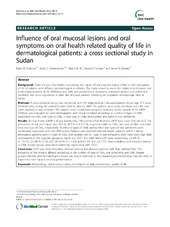| dc.contributor.author | Suliman, Nada M. | en_US |
| dc.contributor.author | Johannessen, Anne Christine | en_US |
| dc.contributor.author | Ali, Raouf Wahab | en_US |
| dc.contributor.author | Salman, Hussein | en_US |
| dc.contributor.author | Åstrøm, Anne Nordrehaug | en_US |
| dc.date.accessioned | 2013-03-07T15:25:04Z | |
| dc.date.available | 2013-03-07T15:25:04Z | |
| dc.date.issued | 2012-07-08 | eng |
| dc.Published | BMC Oral Health 12:19 | |
| dc.identifier.issn | 1472-6831 | |
| dc.identifier.uri | https://hdl.handle.net/1956/6400 | |
| dc.description.abstract | Background: There are only few studies considering the impact of oral mucosal lesions (OML) on the oral quality of life of patients with different dermatological conditions. This study aimed to assess the relationship between oral health-related quality of life (OHRQoL) and OML and reported oral symptoms, perceived general and oral health condition and caries experience in adult skin diseased patients attending an outpatient dermatologic clinic in Sudan. Methods: A cross-sectional survey was carried out with 544 diagnosed skin diseased patients (mean age 37.1 years, 50 % females), during the period October 2008 to January 2009. The patients were orally examined and OML and caries experience was recorded. The patients were interviewed using the Sudanese Arabic version of the OIDP. OHRQoL was evaluated by socio-demographic and clinical correlates according to number of types of OML diagnosed (no OML, one type of OML, > one type of OML) and number and types of oral symptoms. Results: An oral impact (OIDP>0) was reported by 190 patients (35.6 %) (mean OIDP total score 11.6, sd = 6.7). The prevalence of any oral impact was 30.5 %, 36.7 % and 44.1 %, in patients with no OML, one type of OML and more than one type of OML, respectively. Number of types of OML and number and types of oral symptoms were consistently associated with the OIDP scores. Patients who reported bad oral health, patients with ≥ 1 dental attendance, patients with>1 type of OML, and patients with ≥ 1 type of oral symptoms were more likely than their counterparts in the opposite groups to report any OIDP. The odds ratios (OR) were respectively; 2.9 (95 % CI 1.9-4.5), 2.3 (95 % CI 1.5-3.5), 1.8 (95 % CI 1.1-3.2) and 6.7 (95 % CI 2.6-17.5). Vesiculobullous and ulcerative lesions of OML disease groups associated statistically significantly with OIDP. Conclusion: OIDP was more frequently affected among skin diseased patients with than without OML. The frequency of the impacts differed according to the number of type of OML, oral symptoms, and OML disease groups. Dentists and dermatologists should pay special attention to skin diseased patients because they are likely to experience oral impacts on daily performances. | en_US |
| dc.language.iso | eng | eng |
| dc.relation.ispartof | <a href="http://hdl.handle.net/1956/7586" target="blank">Oral Mucosal Lesions and Oral Health-Related Quality of Life in Persons Attending a Dermatology Clinic in Khartoum, Sudan</a> | eng |
| dc.rights | Attribution CC BY | eng |
| dc.rights.uri | http://creativecommons.org/licenses/by/2.0/ | eng |
| dc.subject | Dermatology | eng |
| dc.subject | Oral mucosal lesions | eng |
| dc.subject | Oral impact on daily performance | eng |
| dc.subject | Quality of life | eng |
| dc.title | Influence of oral mucosal lesions and oral symptoms on oral health related quality of life in dermatological patients: a cross sectional study in Sudan | en_US |
| dc.type | Peer reviewed | |
| dc.type | Journal article | |
| dc.description.version | publishedVersion | en_US |
| dc.rights.holder | Copyright 2012 Suliman et al.; licensee BioMed Central Ltd. | |
| dc.identifier.doi | https://doi.org/10.1186/1472-6831-12-19 | |
| dc.identifier.cristin | 937941 | |
| dc.source.journal | BMC Oral Health | |
| dc.source.40 | 12 | |
| dc.source.14 | 19 | |

